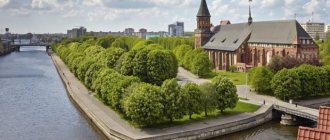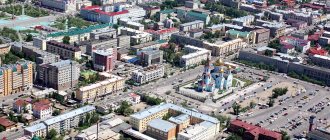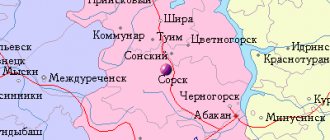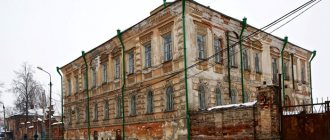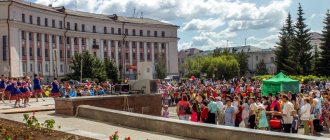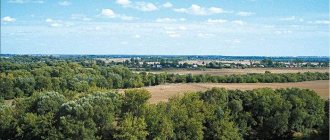City IlanskyCountry
| |||||||||||||||||||||||||||||
| Ilansky Moscow |
| Krasnoyarsk Ilansky |
Audio, photo and video
on Wikimedia Commons
K: Settlements founded in 1646
Ilansky
- a city (since 1939) in Russia, the administrative center of the Ilansky district of the Krasnoyarsk Territory.
Story
Founded in 1645 as the village of Ilanskaya. Named after its location on the Ilanka River. Hydronym on behalf of the local prince Ilanka (distorted Oilan), whose family lived in these places. In April 1733, the Senate issued a decree on the construction of the Siberian-Moscow highway. The history of the emergence of the settlement on the site of the present city of Ilansky must be connected with this date and this document.
Roads - thin threads linking together a remote and vast region - gave new life. From Tomsk to Irkutsk, the reconstruction of the highway was carried out under the leadership of Captain-Commander Vitus Bering. In 1734, Bering examined a section of the Krasnoyarsk-Kansk-Tulun highway and made orders for its construction, outlined the locations of eleven post stations, six of them east of Kan. They were supposed to build a house for travelers and a hut for coachmen with a barn and hayloft. One of these stanzas was the settlement near the Ilanka River.
In 1894, in connection with the construction of the Trans-Siberian Railway, five miles from the village. Ilansky began construction of a depot and station. A settlement arose at Ilanskaya station. The economic structure of the village has changed. Ilansky (modern name Old Ilan): trades related to the railway arose (logging for sleepers and buildings, burning charcoal for the station's forges).
At the beginning of the twentieth century, Ilanskaya was one of the few proletarian centers of revolutionary struggle in Siberia. Railway workers at the Ilanskaya station played a significant role in the revolutionary movement and actively participated in all political protests and strikes, and were active participants in the first Russian revolution of 1905-1907. On January 12, 1906, workers at the station depot “were subjected to brutal reprisals” by the punitive detachment of General Meller-Zakomelsky, who called the station “a nest of revolutionaries.” Then 17 people died, 22 were injured, and 73 participants in the gathering were arrested[2]. Deputy Nikolai Nikolaevsky spoke about these events in Ilanskoye in his speech at a meeting of the State Duma on June 27, 1906.
In December 1918, the Ilan workers, together with the workers of Kansk, took an active part in the armed uprising against the Kolchakites, which was brutally suppressed by the White Guards. Several monuments and memorial sites associated with these events have been preserved.
In the 1920-1930s. Ilanians are active participants in socialist construction. An independent carriage section with its own repair shops was separated from the locomotive depot, new production workshops were built, and the railway track was completely restored. In the 1930s, Ilan railway workers set a number of Stakhanov records (B. Rydzevsky, L. Petrov, V. Ponosov, Belousov, etc.). In memory of the labor exploits of Ilan's Stakhanovite train drivers, an EM steam locomotive was installed on the station square in Ilansky.
In 1941-1945. Thousands of Ilan residents fought with the enemy on the fronts of the Great Patriotic War, many of them were awarded orders and medals, and A.K. Korneev, V.I. Shabalin, A.S. Aleksandrov, I.I. Kryuk were awarded the title of Hero of the Soviet Union.
By the end of the war, the region found itself in difficult conditions, especially the collective farms. Homestead farming and collective gardening began to develop intensively. General mechanization began in the district's farms; from 1950 to 1970, work was carried out to consolidate collective farms and village councils. By 1970, there were 8 collective farms out of 69 and 9 rural councils, a city council and a district council left in the region. In the 1960-1980s, the construction of schools, kindergartens, shops, complex reception and medical assistant stations, agricultural facilities and housing was actively carried out. During these years, a railway station building, a Palace of Culture for railway workers, a reinforced concrete plant, a dairy plant, a bakery, a clothing factory, and a public service center were built in Ilansky during these years.
District workers actively participated in agricultural exhibitions at VDNKh. Great successes were achieved by the millionaire collective farm of the Order of Lenin “Red Grain Grower” (chairman B.K. Tolasov) and the Order of the October Revolution named after. VII Congress of Soviets (chairman V.P. Uss). For their great contribution to the development of agricultural production, Boris Konstantinovich Tolasov, Viktor Petrovich Uss, Vasily Vladimirovich Mironov were awarded the high title of Hero of Socialist Labor.
The names of many famous people in the region are associated with the Ilan region. These are I. P. Artyukhov (Rector of KSMA), V. I. Dolgikh (First Secretary of the Krasnoyarsk Regional Committee of the CPSU), A. I. Lukovets (famous journalist), A. E. Lychkovsky (Honored Pilot of Russia), G. L. Ruksha (Honored Worker of Culture), N.P. Silkova (Secretary of the Regional Committee of the CPSU), A.V. Uss (Chairman of the Legislative Assembly of the Krasnoyarsk Territory), P.F. Khalipov (Deputy Army Commander), etc.[3].[4][ 5]
Chronicle of the Ilansky region
Chronicle of the Ilansky region
The village of Ilanskoye is located on the small Ilanka River in a swampy and unhealthy area, 247 versts from the provincial city of Krasnoyarsk and 27 versts from the district Kansk. It was founded in the 30s of the 18th century in connection with the construction of the Moscow Highway. The decree on the construction of the longest tract in the world was issued by the Senate on March 16, 1733 after the start of the second Kamchatka expedition. “The experienced Vitus Bering was entrusted with assigning camps from which places to transport mail in summer and winter,” and organizing the chase.
The designated sites for stations and winter quarters east of Krasnoyarsk were examined by Bering himself. Already on June 17, 1734, he reported to the Admiralty Board: “Following from the village of Esaulov to Irkutsk, I saw ... convenient places for the village and the establishment of postal machines.” Due to the small population and vast spaces, postal stations (“camps”) were placed only 50-60 miles away and near large rivers. On the Krasnoyarsk-Kan section there were stations and winter quarters in 1735-1739. were located on the rivers Kuskun, Balai, Uyar, Rybnaya, Kan, Ilan, Poima, Tumanshet, Biryusa, Uda, Tyrbyr, Kurzyr. Usually the station consisted of a “black hut with a light room” or an upper room and outbuildings where stand horses were kept and fodder was stored. Parties of exiles were sent to settle at the station. Thus, at the Ilanskaya station, in the new Tinsky winter quarters, at the Poiminskaya and Klyuchinskaya stations in 1769, 1770, 1771 and 1773, several parties brought from the Kazan province were stationed.
With the formation of the Yenisei province in 1822 as an independent administrative-territorial unit, the Ilan volost became part of the Kansky district. By 1860, the Ilanskaya volost was liquidated, and Ilanskoye itself became part of the Antsirskaya volost of the same district.
In 1826, the Ilansky Sretensky parish was opened in the village, separated from Kansky. The wooden double-altar church (in honor of the Presentation of the Lord and in honor of St. Nicholas the Wonderworker) was built in the same 1826. The parish was opened at the request of Count M.M. Speransky, the first general governor of Eastern Siberia. The first parishioners, according to the “Book of Parishes of the Yenisei Diocese,” were exiles. The parish consisted of the village of Ilanskoye and the villages of Karapsel and Stepanovo. There were houses of prayer in Stepanovo and Karapsel. In 1860, the priest of the Ilan church was Ioann Grigorievich Konovalov. The parable consisted of a priest who received 400 rubles from the treasury. per year, and a psalm-reader, who was paid 145 rubles. In addition, 240 poods of prayers were collected for the priest and 84 poods for the psalm-reader. The total parishioners in 1916 were 756 men and 735 women. During this period, the church had tithes of the estate and 52 tithes of hay land.
The population by this time was mainly old-timers. In December 1864, a church and parish school was opened in the village, located in a public building. There were 20 boys studying there, and priest I.G. became the mentor. Konovalov. In 1891, the Ilan two-class parochial school began its work, in which in 1911 there were 20 boys and 13 girls. It was taught by the head of the school Elena Ivanovna Ezhova (2nd grade), Elizaveta Zavyalova (1st grade), and the law teacher priest Alexander Konovalov. In 1910, the Ilan one-class school opened.
In 1913, a small loan partnership was organized in the village, and in 1914 a consumer society was organized.
With the construction of the Siberian railway and the organization of a depot three miles from Ilansky around 1894-1895. The settlement of Ilansky arose. The demand for workers in various specialties caused a massive supply. The area close to Ilanskoye began to quickly be populated not only by newcomer workers, but also by peasants from the village itself. The estates were occupied without permission, buildings were erected without the consent of the Kan forester Volkov. The local government intended to create a number of government quitrent articles in this territory, but the lands remained under the jurisdiction of the Ilan rural society.
In September 1900, at the Ilanskaya station, on the initiative of the former head of the railway service, Kornienko, the Ilansky Alexander Nevsky parish was opened. Even before the opening of an independent parish, Kornienko built a small church in 1899. The parish was located in an open area that was not healthy due to the proximity of swamps and the lack of clean water. A wooden single-altar church (in the name of the Holy Prince Alexander Nevsky) served the employees and workers of the Ilansk station and the railway line from the Vengerka stop in the east to the Kansk station in the west . The church had a library consisting of books with religious, moral, social and anti-alcohol content.
Many workers began to build their own houses, others rented apartments. Thanks to the good salaries of railway employees, even unskilled workers who received up to 100 rubles a month - very good money for those times - felt more than secure. The drivers and their assistants were not worth mentioning. Apartment prices have increased to 50 rubles. per month. Such favorable living conditions caused a sharp influx of population, amounting to almost 7 thousand people by 1908. The settlement had 465 houses, 35 commercial enterprises, including 4 shops, a tavern and an I.O. pharmacy. Romanovsky. Twice a week there was a bazaar in Ilansky, attracting residents of Antsirskaya, Ustyanskaya, Tinskaya and Kucherdaevskaya volosts. The question was raised about building a school and a chapel (church) for Catholics there.
Understanding the importance of railway enterprises for the development of the city, the Kansk City Duma in 1908 sent a petition to the Yenisei provincial administration to transfer the main depot from the Ilanskaya station to Kansk. The Duma explained its forgiveness solely by concerns about state benefits and was even ready to give up the required amount of land for a new depot for free: “Currently, our only concern in the Far East is the Siberian Railway, which was created in view of this, subject to a grandiose construction. By the way, in order to increase the movement of 40-48 pairs of trains, it was considered necessary to build a water supply system from the right bank of the Kan River to the Ilanskaya station, where the main locomotive depot for 36 locomotives is located... For the purposes of national defense, i.e. First of all, for the military department, it is safer not to depend on the location of a huge water pipeline running in a desert, taiga area.”
The residents of Kansk were supported only by the Irkutsk general-governor. The Minister of Internal Affairs, the Minister of Railways, and, of course, specialists opposed it. From a letter from the Minister of Railways to the Irkutsk Governor General: “Location of the depot at the station. Ilanskaya... is most consistent with the rational operation of steam locomotives and the observance of proper standards of continuous service and rest for locomotive crews. In addition, when moving the depot from Ilanskaya to Kansk, use the existing ones at the station. It would seem extremely unprofitable for the Ilan workshops, since for small, even the most insignificant repairs, it would be necessary to send steam locomotives from the Kansk depot to the Ilan workshops... in addition to unnecessary loss of time, this would reduce the throughput of the road section and would require an increase in the inventory of steam locomotives... In view of this, the petition Kansk about moving the depot from the station. Ilanskaya to Kansk, as not meeting the requirements for proper operation of the railway and causing additional one-time expenses, was rejected by me.”
The head of the Ilanskaya station in 1903 was Nikolai Petrovich Protopopov, the head of the 18th section of the track and building repair service - railway engineer, collegiate secretary Pyotr Lukich Belyavsky; assistant chief - Innokenty Nikolaevich Kovalev. The head of the 10th traction section is engineer-technician Evgeniy Petrovich Ivanov, his assistant is Al. Porokhovnikov.
In 1915, the acting head of the 20th section of the traction service was construction engineer Ivan Pavlovich Chernyshev; inspector of the service of the 10th section - retired engineer and technician Nikolai Klimentovich Korchinsky; Acting head of the 10th section of the traction service is hereditary honorary citizen Vikenty Matveevich Chapsky, his assistants are mechanical engineer Alexander Aleksandrovich Tupikov, honorary citizen Alexey Paramonovich Anisimov, Doctor of the 22nd section of the Tomsk Railway District, located at the station. Ilansky’s doctor was Veniamin Iosifovich Rakitin.
The children of station workers attended two ministerial schools - two-class railway schools for men and women. The first was opened in 1898, there were six teachers and two teachers - the head Vasily Tikhonovich Tikhonov, the teacher priest Alexander Vasilyevich Konovalov, teacher of the Law of God Alexander Antonovich Chugunin, teachers Vasily Dmitrievich Delov, Efim Dmitrievich Evtikhiev, Maria Ivanovna Tikhonova, Elena Vikentievna Chapskaya, Nadezhda Vilaretovna Delova and Vasily Vasilievich Neklyudov. 302 boys studied at this school.
At the girls' school, 232 girls were taught by the head Valentina Aleksandrovna Kulchenko, Vera Ivanovna Gusenko and Natalya Konstantinovna Gerasimova. In addition, there were 4 teachers of the law in the schools. The honorary guardian of the two-class railway school was railway engineer P.L. Belyavsky. On August 19, 1914, a Trustee Council for providing assistance to war victims was opened in Ilanskoye. At the station there was a medical center (1903 - doctor Apollo Andreevich Tsvetaev), a people's reading room, a stage for staging plays and a cinema. The parish of the Alexander Nevsky Church at Ilanskaya station in 1915 amounted to 1,373 people (686 men and 687 women).
The growth of the settlement was facilitated by the Russian-Japanese War with an increased demand for labor. The continued growth of the settlement - especially in 1904-1907. - necessitated a double plan, and by 1914 the Ilansky settlement was closer to the village in its territory. The distance between them was 50 - 60 fathoms.
In 1907, the trustee of the Ilansky rural society submitted a petition to transform the village of Ilansky and the adjacent settlement formed along the railway line into the Novo-Ilansky urban settlement with the introduction of simplified urban civil administration in it by converting the local population into the petty bourgeois class and with the transfer of all lands, property and capital of the Ilan rural society.
The correspondence took several years. The resolution of the issue was postponed due to the fact that at that time the government was considering a bill on village management. And soon the Ilanians themselves changed their minds. The reason was the fact that with the completion of the construction of the railway track, the life of the settlement came to a standstill. The construction of residential buildings stopped, many buildings were sold, trade was curtailed, and the population fell sharply. In 1914, 4,600 people lived in Ilanskoye itself and the settlement near it. Of these, 14 were nobles, 4 honorary citizens, 18 merchants, 667 burghers, representatives of the clergy, 3,689 peasants, 203 settlers. They represented various religious denominations: 3982 Orthodox, 397 Catholics, 13 Lutherans, 154 Jews, 54 Mohammedans. One person had a higher education, 17 had a secondary education, about 200 had a lower education or home education.
By occupation during this period, the population was distributed as follows: 67 traders, 15 artisans, 110 cultivators, 110 artisans, 600 railway employees, the rest were laborers. With the exception of five more or less wealthy peasants and 10 merchants (from the class of commoners), the rest of the population of Ilansky could safely be classified as people of average and even limited income. Residents of the settlement of Ilanskoye began to petition for the allocation of land to them, not counting on other incomes.
In 1914, in the village of Ilanskoye there was only one stone building (valued at 24 thousand rubles). The total turnover of all commercial and industrial enterprises was 328 thousand rubles. In the village and settlement there were two churches, a church, two two-year schools, a postal and telegraph office (head Pyotr Nikolaevich Kuznetsov, postal employee Nikolai Ivanovich Kargin) and a private pharmacy I.O. Romanovsky (listed in 1907). In addition, the State Savings Bank, a state-owned wine shop, a bakery store, and a fire brigade operated in the village. In 1908, a photograph that belonged to the Kan merchant Stepan Maksimovich Fomin was discovered.
The improvement of the Ilansky settlement, in comparison with the village, left much to be desired. There was no hospital or almshouse, library, or street lighting. The commoners living in the settlement refused to spend money on public needs, while the rural community spent only 10 thousand rubles on school equipment and water supply for the settlement. From year to year from 2 to 3 thousand rubles. rural society spent on maintaining a fire train, quarters for prisoners, a cholera barracks, a slaughterhouse and cleaning the streets.
Notable residents
- Vladimir Ivanovich Dolgikh (1924) - Soviet and Russian statesman and party leader. Secretary of the CPSU Central Committee, candidate member of the Politburo of the CPSU Central Committee. Deputy of the State Duma of the 6th convocation. Member of the Federation Council. Twice Hero of Socialist Labor.
- Elovoy, Oleg (1967-2001) - Russian artist, director, initiator and creator of the Museum of Simple Art of the Urals and Siberia.
- Alexander Viktorovich Uss
Born on November 2, 1954 in the village of Novogorodka, Ilansky district. He received his education at KSU. Chairman of the Legislative Assembly of the Krasnoyarsk Territory, member of the Federation Council of the Federal Assembly of two convocations. Representative of Russia in the Chamber of Regions of the Congress of Local and Regional Authorities of Europe, member of the Council on Foreign and Defense Policy. Doctor of Law, Professor.
- Nina Prokopyevna Silkova
Born in the city of Ilansky. Graduate of Ilan secondary school No. 1. Pioneer leader of the Yuzhno-Alexandrovsk secondary school in the Ilan district, first secretary of the Ilansky Komsomol Regional Committee, secretary of the Komsomol regional committee, secretary of the Central Communist Party of the Soviet Union of Krasnoyarsk, secretary of the Krasnoyarsk CPSU regional committee, deputy minister of culture of the USSR, secretary of the Communist Party of the Russian Federation Central Committee, advisor to the president Russian Olympic Committee, worked in the State Duma for eight years. Executive Director of the Board of the Krasnoyarsk Community in Moscow. Candidate of Historical Sciences.
Help numbers
| p/p | Phone fax | Address | ||
| 1 | Reception room of the chief physician Chief physician - Luchkiv Yaroslav Eremeevich | 8(39173)2-12-04 8(39173)2-12-04 | [email protected] | st. Meditsinskaya, 9, hospital, floor 2 |
| 2 | Adult clinic/registry | 8(39173)2-12-41 | [email protected] | st. Meditsinskaya, 4a |
| 3 | Deputy Chief Physician for Medical Care of the Population - Gusarov Denis Nikolaevich | 8(39173)2-17-87 | [email protected] | st. Meditsinskaya, 4a, floor 1, room 6 |
| 4 | Deputy Chief Physician for Medical Affairs - Alexander Sergeevich Chernousov | 8(39173)2-17-46 | [email protected] | st. Meditsinskaya, 9, hospital, floor 2 |
| 5 | Children's clinic registry | 8(39173)2-12-44 | st. Lenina, 76 | |
| 6 | Dentistry | 8(39173)2-16-87 | st. Lenina, 76 | |
| 7 | Accounting Chief Accountant - Ryabtseva Natalya Vladimirovna | 8(39173)2-18-06 | [email protected] | st. Meditsinskaya, 9, hospital, floor 1 |
| 8 | Economic Department Deputy Chief Physician for Economic Affairs - Tatyana Nikolaevna Ostapenko | 8(39173)2-14-34 | [email protected] | st. Meditsinskaya, 9, hospital, floor 1 |
| 9 | HR Department Head of HR Department - Anna Aleksandrovna Knyazeva | 8(39173)2-17-22 | i [email protected] | st. Meditsinskaya, 9, hospital, floor 1 |
| 10 | Lawyer - Zakharova Irina Sergeevna | 8(39173)2-17-22 | st. Meditsinskaya, 9, hospital, floor 1 | |
| 11 | Programmer | 8(39173)3-16-06 | st. Meditsinskaya, 9, hospital, floor 1 | |
| 12 | Prevention Department Senior paramedic - Olga Gennadievna Ryabova | 8(39173)2-16-63 | [email protected] | st. Meditsinskaya, 4a, floor 2, room 33 |
| 13 | Organizational and methodological department | 8(39173)2-16-64 | [email protected] | st. Meditsinskaya, 4a, floor 2, room 52 |
| 14 | ACS department | 8(39173)2-11-01 | [email protected] | st. Meditsinskaya, 4a, floor 1, rooms 10-13 |
| 15 | Therapeutic department Head - Svetlana Nikolaevna Dodonova | 8(39173)3-10-00 | st. Meditsinskaya, 9, hospital, floor 4 | |
| 16 | Surgery Department Head - Yukhanov Vadim Anatolyevich | 8(39173)2-12-08 | st. Meditsinskaya, 9, hospital, floor 3 | |
| 17 | Emergency room | 8(39173)2-19-05 | st. Meditsinskaya, 9, hospital |
Notes
- ↑ 12
www.gks.ru/free_doc/doc_2016/bul_dr/mun_obr2016.rar Population of the Russian Federation by municipalities as of January 1, 2021 - State Archive of the Krasnoyarsk Territory (1905-07) - [Krasnoyarsk-archives.rf/upload/files/o%20revolyutsii%201905-1907%20gg..doc F.595. Op.63. D.4087. L.252]
- Vakhrin Yu.I. Ilanskaya
. - Krasnoyarsk: Book. publishing house, 1989. - 208 p. - [region.krasu.ru/cities/ilanskiy Ilansky
] based on materials from Shorokhov L.P. - [www.sobolznaet.ru/bbs.php?bbs=21592116 75 years since the formation of the ILAN DISTRICT
] based on materials from Sharikova S.P. - ↑ 12345678910111213
www.MojGorod.ru/krsnjar_kraj/ilanskij/index.html People's encyclopedia “My City”. Ilansky - [demoscope.ru/weekly/ssp/rus59_reg2.php All-Union Population Census of 1959. The size of the urban population of the RSFSR, its territorial units, urban settlements and urban areas by gender] (Russian). Demoscope Weekly. Retrieved September 25, 2013. [www.webcitation.org/6GDOghWC9 Archived from the original on April 28, 2013].
- ↑ 123
[krasstat.gks.ru/wps/wcm/connect/rosstat_ts/krasstat/resources/5ed87c8043b9ed899ea29ed06954faf7/1.+Number+and+location+of the+population+of the Krasnoyarsk+krai.xls Number and distribution of the population of the Krasnoyarsk Territory (according to the 2002 All-Russian Population Census of the year). Sheet “5. Population of districts, urban settlements, regional centers and rural settlements with a population of 3 thousand or more people”]. Retrieved April 28, 2021. [www.webcitation.org/6h6j3VuJ7 Archived from the original on April 28, 2016]. - [www.perepis2002.ru/ct/doc/1_TOM_01_04.xls All-Russian Population Census 2002. Volume. 1, table 4. Population of Russia, federal districts, constituent entities of the Russian Federation, districts, urban settlements, rural settlements - regional centers and rural settlements with a population of 3 thousand or more]. [www.webcitation.org/65AdCU0q3 Archived from the original on February 3, 2012].
- [www.gks.ru/bgd/regl/B09_109/IssWWW.exe/Stg/d01/tabl-21-09.xls Number of permanent population of the Russian Federation by cities, urban-type settlements and districts as of January 1, 2009]. Retrieved January 2, 2014. [www.webcitation.org/6MJmu0z1u Archived from the original on January 2, 2014].
- [krasstat.gks.ru/wps/wcm/connect/rosstat_ts/krasstat/resources/20d7bd804eba60379580f5263284271d/1.10.xlsx All-Russian Population Census 2010. Results for the Krasnoyarsk Territory. 1.10 Population of city districts, municipal districts, mountains. and sat down. settlements and populated areas]. Retrieved October 25, 2015. [www.webcitation.org/6cXLrGwbE Archived from the original on October 25, 2015].
- [www.gks.ru/free_doc/doc_2012/bul_dr/mun_obr2012.rar Population of the Russian Federation by municipalities. Table 35. Estimated resident population as of January 1, 2012]. Retrieved May 31, 2014. [www.webcitation.org/6PyOWbdMc Archived from the original on May 31, 2014].
- [www.gks.ru/free_doc/doc_2013/bul_dr/mun_obr2013.rar Population of the Russian Federation by municipalities as of January 1, 2013. - M.: Federal State Statistics Service Rosstat, 2013. - 528 p. (Table 33. Population of urban districts, municipal districts, urban and rural settlements, urban settlements, rural settlements)]. Retrieved November 16, 2013. [www.webcitation.org/6LAdCWSxH Archived from the original on November 16, 2013].
- [www.gks.ru/free_doc/doc_2014/bul_dr/mun_obr2014.rar Table 33. Population of the Russian Federation by municipalities as of January 1, 2014]. Retrieved August 2, 2014. [www.webcitation.org/6RWqP50QK Archived from the original on August 2, 2014].
- [www.gks.ru/free_doc/doc_2015/bul_dr/mun_obr2015.rar Population of the Russian Federation by municipalities as of January 1, 2015]. Retrieved August 6, 2015. [www.webcitation.org/6aaNzOlFO Archived from the original on August 6, 2015].
- taking into account the cities of Crimea
- [www.gks.ru/free_doc/doc_2016/bul_dr/mun_obr2016.rar Population of the Russian Federation by municipalities as of January 1, 2021. Table “31. Population of cities and towns by federal districts and constituent entities of the Russian Federation as of January 1, 2021.” RAR archive (1.0 MB)]
Ilansky
(Krasnoyarsk region)
OKATO code:
04218501
Founded:
1645
Urban settlement since:
1929
City since:
1939 City of district subordination (Ilansky district of the Krasnoyarsk Territory)
Center:
Ilansky district
Telephone code (reference phone)
| 39173***** | 21-2-92 |
Deviation from Moscow time, hours:
4
Geographical latitude:
56°14′
Geographical longitude:
96°04′
Altitude above sea level, meters:
280 Sunrise and sunset times in the city of Ilansky
Excerpt characterizing Ilansky
“Excuse me, Your Excellency,” he began (Pierre was well acquainted with this senator, but considered it necessary to address him here officially), “although I do not agree with Mr.... (Pierre paused. He wanted to say mon tres honorable preopinant), [my esteemed opponent,] - with Mr.... que je n'ai pas L'honneur de connaitre; [whom I do not have the honor to know] but I believe that the class of nobility, in addition to expressing its sympathy and admiration, is also called upon to discuss the measures by which we can help the fatherland. I believe,” he said, inspired, “that the sovereign himself would be dissatisfied if he found in us only the owners of the peasants whom we give to him, and ... the chair a canon [fodder for guns] that we make of ourselves, but I wouldn’t find any co…co… advice in us. Many moved away from the circle, noticing the senator’s contemptuous smile and the fact that Pierre spoke freely; only Ilya Andreich was pleased with Pierre’s speech, just as he was pleased with the speech of the sailor, the senator, and in general always with the speech that he last heard. “I believe that before discussing these issues,” Pierre continued, “we must ask the sovereign, most respectfully ask His Majesty to communicate to us, how many troops we have, what is the situation of our troops and armies, and then... But Pierre did not have time Having finished speaking these words, he was suddenly attacked from three sides. The one who attacked him the most was a Boston player who had known him for a long time and was always well disposed toward him, Stepan Stepanovich Apraksin. Stepan Stepanovich was in his uniform, and, whether because of the uniform or for other reasons, Pierre saw a completely different person in front of him. Stepan Stepanovich, with senile anger suddenly appearing on his face, shouted at Pierre: “Firstly, I’ll tell you that we have no right to ask the sovereign about this, and secondly, if the Russian nobility had such a right, then the sovereign cannot ask us answer. The troops move in accordance with the movements of the enemy - the troops depart and arrive... Another voice of a man of average height, about forty years old, whom Pierre had seen among the gypsies in the old days and knew to be a bad card player and who, also changed in uniform, moved closer to Pierre and interrupted Apraksina. “And this is not the time to speculate,” said the voice of this nobleman, “but we need to act: the war is in Russia.” Our enemy is coming to destroy Russia, to desecrate the graves of our fathers, to take away their wives and children. – The nobleman hit himself in the chest. “We will all get up, we will all go, all for the Tsar Father!” - he shouted, rolling his bloodshot eyes. Several approving voices were heard from the crowd. “We are Russians and will not spare our blood to defend the faith, the throne and the fatherland. But we must leave nonsense if we are sons of the fatherland. “We will show Europe how Russia is rising up for Russia,” the nobleman shouted. Pierre wanted to object, but could not say a word. He felt that the sound of his words, no matter what thought they contained, was less audible than the sound of the words of an animated nobleman. Ilya Andreich approved from behind the circle; some smartly turned their shoulders to the speaker at the end of the phrase and said: “That’s it, that’s it!” This is true! Pierre wanted to say that he was not averse to donating money, men, or himself, but that he would have to know the state of affairs in order to help him, but he could not speak. Many voices shouted and spoke together, so that Ilya Andreich did not have time to nod to everyone; and the group grew larger, broke up, came together again and all moved, buzzing with conversation, into the large hall, towards the large table. Not only was Pierre unable to speak, but he was rudely interrupted, pushed away, and turned away from him as if from a common enemy. This did not happen because they were dissatisfied with the meaning of his speech - it was forgotten after a large number of speeches that followed it - but in order to animate the crowd it was necessary to have a tangible object of love and a tangible object of hatred. Pierre was the last. Many speakers spoke after the animated nobleman, and everyone spoke in the same tone. Many spoke beautifully and originally. The publisher of the Russian Bulletin, Glinka, who was recognized (“a writer, a writer!” was heard in the crowd), said that hell should reflect hell, that he saw a child smiling in the flash of lightning and the rumble of thunder, but that we will not be this child. - Yes, yes, with thunder! – they repeated approvingly in the back rows. The crowd approached a large table, at which, in uniforms, in ribbons, gray-haired, bald, seventy-year-old noblemen sat, almost all of whom Pierre had seen in their homes with jesters and in clubs outside Boston. The crowd approached the table, still buzzing. One after another, and sometimes two together, pressed from behind to the high backs of chairs by the overlapping crowd, the speakers spoke. Those standing behind noticed what the speaker had not said and were in a hurry to say what was missed. Others, in this heat and cramped space, rummaged in their heads to see if there was any thought, and hurried to say it. The old noblemen familiar to Pierre sat and looked around first at this one, then at the other, and the expression of most of them only said that they were very hot. Pierre, however, felt excited, and the general feeling of the desire to show that we didn’t care, expressed more in sounds and facial expressions than in the meaning of speeches, was communicated to him. He did not renounce his thoughts, but he felt guilty of something and wanted to justify himself. “I only said that it would be more convenient for us to make donations when we know what the need is,” he said, trying to shout over other voices. One of the nearest old men looked back at him, but was immediately distracted by a scream that began on the other side of the table. - Yes, Moscow will be surrendered! She will be the redeemer! - one shouted. - He is the enemy of humanity! - shouted another. - Let me speak... Gentlemen, you are crushing me... At this time, Count Rostopchin entered with quick steps in front of the parting crowd of nobles, in a general's uniform, with a ribbon over his shoulder, with his protruding chin and quick eyes. “The Emperor will be here now,” said Rostopchin, “I just came from there.” I believe that in the position we find ourselves in, there is not much to judge. The Emperor deigned to gather us and the merchants,” said Count Rastopchin. “Millions will flow from there (he pointed to the hall of merchants), and our job is to field a militia and not spare ourselves... This is the least we can do!” Meetings began between some nobles sitting at the table. The entire meeting was more than quiet. It even seemed sad when, after all the previous noise, old voices were heard one by one, saying one: “I agree,” the other, for variety: “I am of the same opinion,” etc. The secretary was ordered to write a decree of the Moscow nobility about the fact that Muscovites, like Smolensk residents, donate ten people per thousand and complete uniforms. The gentlemen who were sitting stood up, as if relieved, rattled their chairs and walked around the hall to stretch their legs, taking someone by the arm and talking. - Sovereign! Sovereign! - suddenly echoed through the halls, and the entire crowd rushed to the exit. Along a wide passage, between the wall of nobles, the sovereign walked into the hall. All faces expressed respectful and frightened curiosity. Pierre stood quite far away and could not fully hear the sovereign’s speeches. He understood only from what he heard that the sovereign was talking about the danger in which the state was, and about the hopes that he placed in the Moscow nobility. Another voice answered the sovereign, reporting about the decree of the nobility that had just taken place. - Gentlemen! - said the sovereign’s trembling voice; the crowd rustled and fell silent again, and Pierre clearly heard the sovereign’s so pleasantly human and touched voice, which said: “I have never doubted the zeal of the Russian nobility.” But on this day it exceeded my expectations. I thank you on behalf of the fatherland. Gentlemen, let us act - time is most valuable... The Emperor fell silent, the crowd began to crowd around him, and enthusiastic exclamations were heard from all sides. “Yes, the most precious thing is... the royal word,” said the sobbing voice of Ilya Andreich from behind, who heard nothing, but understood everything in his own way. From the hall of the nobility the sovereign went into the hall of the merchants. He stayed there for about ten minutes. Pierre, among others, saw the sovereign leaving the merchants' hall with tears of tenderness in his eyes. As they later learned, the sovereign had just begun his speech to the merchants when tears flowed from his eyes, and he finished it in a trembling voice. When Pierre saw the sovereign, he went out, accompanied by two merchants. One was familiar to Pierre, a fat tax farmer, the other was a head, with a thin, narrow beard, yellow face. They both cried. The thin man had tears in his eyes, but the fat farmer wept like a child and kept repeating: “Take both life and property, Your Majesty!” Pierre no longer felt anything at that moment except the desire to show that he didn’t care about anything and that he was ready to sacrifice everything. His speech with a constitutional direction appeared to him as a reproach; he was looking for an opportunity to make amends for it. Having learned that Count Mamonov was donating the regiment, Bezukhov immediately announced to Count Rostopchin that he was giving up a thousand people and their contents.
